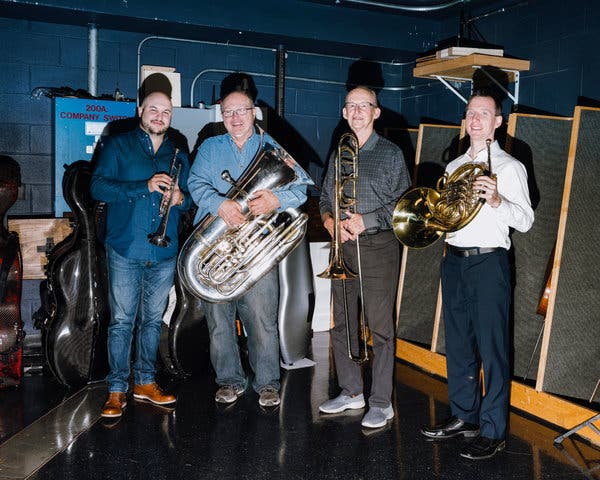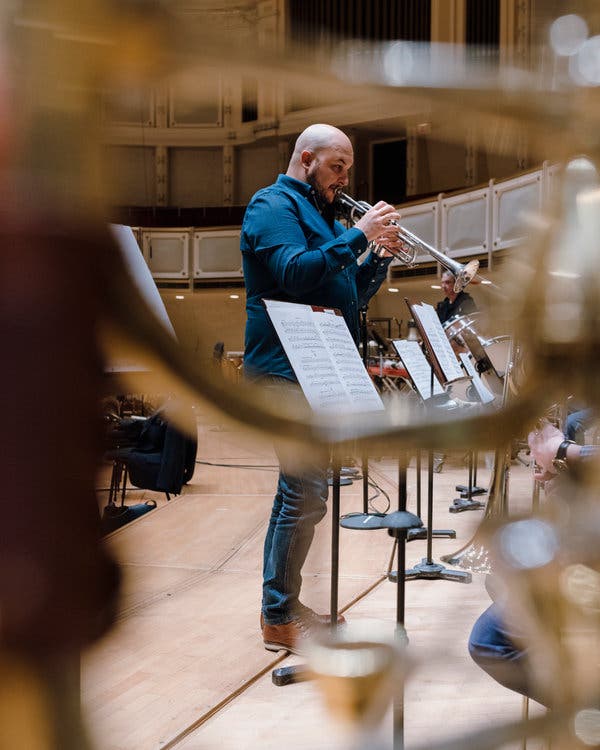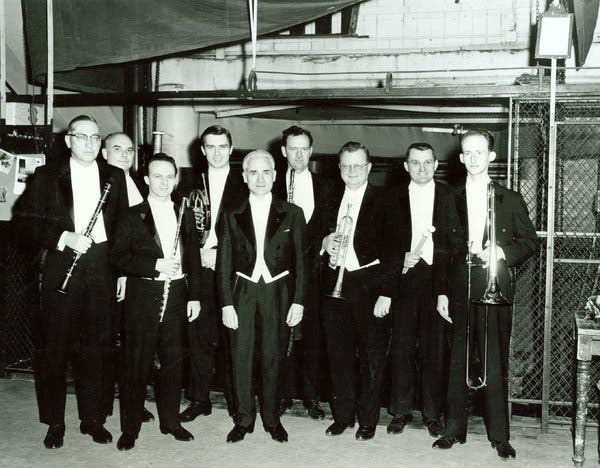As the orchestra’s storied brass section breaks in two young musicians, listen to what has made it so renowned.

Credit…Lyndon French for The New York Times
The New York Times. Nov.18, 2019 by Michael Cooper
What distinguishes one top-rank orchestra from another? For the Chicago Symphony Orchestra, it’s long been the brass.
For decades, the “Chicago brass” has been prized for its majesty, virtuosity and sheer power. From its modern-day origins under Rafael Kubelik and Fritz Reiner to the brawny blasts of the Georg Solti era to the subtler approaches taken by Daniel Barenboim and now Riccardo Muti, brass has long been central to the ensemble’s sound.
“The Chicago brass: This was a way of referring to the Chicago Symphony even when I was a young student in the conservatory in Milano,” said Mr. Muti, 78, who is in his 10th season as music director.
Mr. Barenboim, Chicago’s conductor from 1991 to 2006, said: “When you become music director of a great orchestra, you have to be able to recognize what belongs to the orchestra: what is characteristic — what is the stomach of the orchestra — and what is the influence of other conductors. And the Chicago brass was part of that stomach, of that unique way of playing.”
So when the orchestra came to Carnegie Hall this weekend with young blood in two key positions — Esteban Batallán, 35, is its new principal trumpet and David Cooper, also 35, its new principal French horn — the pressure was on to show that Chicago’s brass is still, to mix metallurgical metaphors, the gold standard.

Both newcomers grew up listening to, and trying to emulate, the Chicago sound. Now, they are joining colleagues steeped in the orchestra’s traditions: Jay Friedman, 80, has been principal trombone since 1965, and Gene Pokorny, 66, principal tuba since 1989.
Whether the Chicago brass would be recognizable in a blind test is open to debate — many of the regional styles that once differentiated orchestras have been sanded over in this age of jet-setting maestros and more peripatetic players — but it is still considered one of the jewels of the orchestral world.
[Read about the still-unique sound of the Vienna Philharmonic.]
After a rehearsal on Friday, several brass players gathered backstage at Carnegie to listen to some classic recordings.
“That’s what’s made the Chicago Symphony brass unique: that sound jumping out of the horn,” Mr. Friedman said as he listened to Rafael Kubelik’s recording of Smetana’s “Ma Vlast,” made in 1952. The recording features two of the architects of the Chicago sound: Arnold Jacobs, its principal tuba from 1944 to ’88, and Adolph (“Bud”) Herseth, its principal trumpet from 1948 to 2001.
Both men overcame physical impediments to dominate their fields. Mr. Jacobs’s lung capacity was sharply reduced by various ailments, so he developed breathing techniques that he passed on to generations of players. (“We want as little tension in the body as we can get, so the torso becomes a resonating chamber,” Mr. Friedman said, summing up the Jacobs technique.)

Credit…The Samuel and Marie-Louise Rosenthal Archives of the Chicago Symphony Orchestra
And Mr. Herseth, a virtuoso who effectively led the brass section for more than half a century, was in a car accident in 1952 in which he broke teeth and damaged his lip — potentially disastrous for a trumpet player. “He didn’t know if he was ever going to play again,” Mr. Friedman said.
Mr. Pokorny called the two men “the bookends” of the section, which was joined by Mr. Friedman in 1962, then by Dale Clevenger as principal horn in 1966, a position he held until 2013. The old sound is still alive in the orchestra — and not only stylistically.
Mr. Batallán plays on Mr. Herseth’s old trumpet, and Mr. Pokorny plays on Mr. Jacobs’s tuba. And the whole horn section plays the same make — Lewis horns, constructed by a Chicago craftsman — which helps their sound blend.
“That’s what we’re talking about right there,” Mr. Friedman said, after listening to three pulse-quickening brass chords in Fritz Reiner’s 1956 recording of Strauss’s “Symphonia Domestica.” “Other orchestras might ease into those chords. It would be great for that style — but that’s just not our style.”
The first time Mr. Cooper heard Georg Solti’s 1971 recording of Mahler’s Seventh Symphony, he said, was on an iPod while snowboarding.
“I was just bombing down the mountain, and I was like, yeah!” said Mr. Cooper, who noted that, in addition to its thrilling power, it also captures the delicate, varied phrasing of Mr. Clevenger’s horn playing. “I’ve never been more pumped. Just so much energy behind it.”
Solti was famous for pushing for a big brass sound — sometimes too big.
“When Solti came, at first he could not get the brass section to play loud enough for him,” Mr. Friedman recalled. “Even on a Schubert symphony.” Mr. Pokorny recalled a violist in the orchestra, Max Raimi, joking that some Solti recordings “reduced the string section to tape hiss.”
But after critics began to complain, Mr. Solti dialed it back, in what Mr. Friedman called “the great diminuendo.” Near the end of Solti’s tenure, he said, a recording of Verdi choruses was stopped when the recording engineer had a novel complaint: He couldn’t hear the brass.
“You can hear all the attacks,” Mr. Batallán said, referring to the decisive way each note is struck in Leonard Bernstein’s 1988 recording of Shostakovich’s Seventh Symphony. “It’s a pure sound, with a clear attack.”
Mr. Pokorny said that when he started in Chicago, one of his first conductors was a guest, Leonard Slatkin, for whom he had played in the St. Louis Symphony Orchestra. “I went to him,” Mr. Pokorny said, “because he knew the Chicago sound, and he knew the St. Louis sound, and I said, ‘What do I have to do to my St. Louis sound to match here?’ And he said that what you really have to do is put a lot of front-end on the note.”
“It’s more attack, and less follow-through,” added Mr. Pokorny. “It’s probably a product of the hall” — Orchestra Hall in Chicago — “more than anything else, because the hall is pretty dead. And he proved to be right.”
“There’s lots of energy — and you can still hear the chorus,” Daniel Gingrich, who joined the horn section in 1975 and served as acting principal horn for the past six years, said of Mr. Muti’s 2010 recording of the Verdi Requiem.
“They are still number one in the world, in my opinion,” Mr. Muti said of the orchestra’s brass, “but also able to meld together with the rest of the orchestra. Not to be only dominant, but in a better balance.”
This desire to keep the brasses in balance is now well known. “I’m very sensitive to the hand going up,” Mr. Pokorny said.
Mr. Friedman quickly chimed in: “Which he rarely does, I have to say. He loves the brass section. Rarely does he give us the hand — only when he absolutely has to.”
